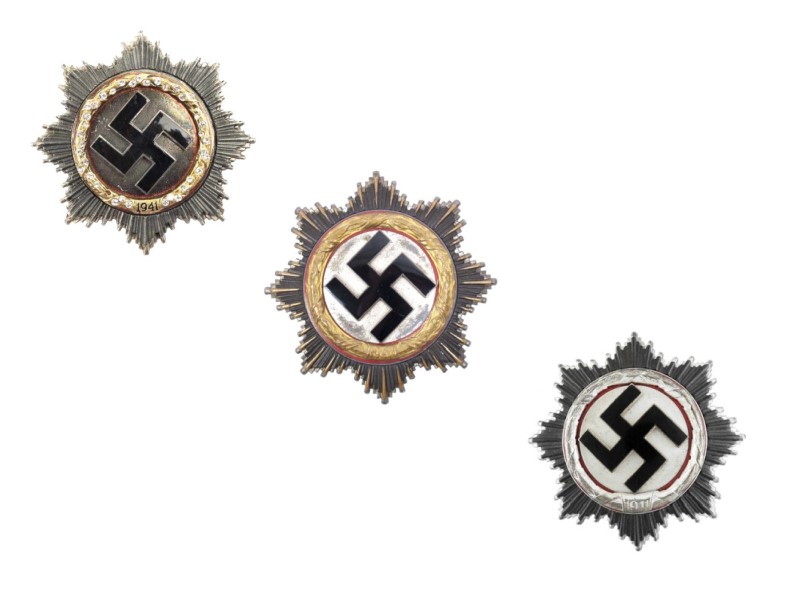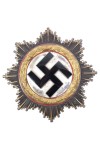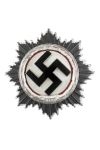Kriegsorden des Deutschen Kreuzes
The German Cross (Deutschen Kreuz) is instituted by Hitler on 28-09-1941. He thought that there should come an extra award to honour the increasing number of military achievements at the front. In Hitler’s opinion was the gap between the Iron Cross 1st Class (Eisernes Kreuz 1 Klasse) and the Knight’s Cross of the Iron Cross (Ritterkreuz des Eizernen Kreuzes) and between the War Merit Cross 1st Class (Kriegsverdienstkreuz 1 Klasse) and the Knight’s Cross of the War Merit Cross (Ritterkreuz des Kriegsverdienstkreuzes) to big and to be able to reward the achievements of his soldiers, he let Pr. Klein of Munich design this new award.
The German Cross came in 2 variants namely the German Cross in Gold (Deutschen Kreuzes ins Gold) and the German Cross in Silver. (Deutschen Kreuzes ins Silber) The only difference between these 2 variants is the colour of the laurel leaf wreath. The German Cross in Gold was awarded for bravery and outstanding achievements in combat but where the Knight’s Cross wasn’t awarded for. The German Cross in Silver was awarded for honourable military services in the execution of the war effort but where the Knight’s Cross wasn’t awarded for. Although the German Cross was instituted to fill in these gaps, the German Cross is a separate award and not a expansion of the Iron Cross or the War Merit Cross line. It was very common that a recipient was awarded with the German Cross after he received the Iron Cross 1st Class or the War Merit Cross 1st Class but also many Knight’s Cross holders were not awarded with the German Cross at all.
The first awardings of the German Cross were on October 18th 1941. It was also possible that 1 recipient was awarded with both variants. All the members of the SS who were awarded with the German Cross, also automatically qualified for the SS-Dead Heads Ring.
The German Cross was worn on the right breast pocket and than above the Spanish Cross (Spanien-Kreuz) if the recipient owned this award. When a recipient was awarded with both German Cross versions, than they were worn underneath each other instead of next to each other. The German Cross was awarded in a black square box with a black velvet base and the lid was covered with white silk. On the outer side of the lid is a fine golden or silver line embossed to represent the corresponding version. Together with the award came an award document. This is a large document with at the top a facsimile of the German Cross. There are two different text versions on the German Cross in Gold and Silver documents and it’s also possible that the large embossed eagle in the lower left corner is replaced with a simple ink stamp. The awarding was also noted in the Soldbuch. Some know producer are; (1) Deschler & Sohn of Munich, (4) Steinhauser & Lück of Lüdenscheid, (20) C.F. Zimmermann of Pforzheim, (21) Gebrüder Godet & Co of Berlin, (134) Otto Klein of Hanau.
A total of 14 military received both the Deutsches Kreuz im Gold (DKiG) and the Deutsches Kreuz im Silber (DKiS). These were:
Robert Bader: DKiG 18.03.1945 & DKiS 14.02.1943;
Jürgen Bennecke DKiG 30.01.1945 & DKiS 15.02.1943;
Wolfgang Bucher DKiG 23.02.1944 & DKiS 14.02.1943;
Hans Hecker DKiG 19.02.1942 & DKiS 19.02.1942;
Odilio L. Globocnik DKiG 07.02.1945 & DKiS 20.01.1945;
Franz Kaiser DkiG 01.0311945 & DKiS 08.07.1943;
Paul H. Meixner DKiG 11.02.1943 & DKiS 06.06.1942;
Ernst Merk DKiG 11.02.1944 & DKiS 06.06.1942;
Helmut Moeller-Althaus DKiG 15.12.1943 & DKiS 30.05.1942;
Walther Rauff DKiG 07.02.1945 & DKiS 20.05.1943;
Felix Schwalbe DKiG 07.12.1944 & DKiS 30.10.1943;
Alfred Thielmann DKiG 08.11.1944 & DKiS 03.12.1942;
Paul W. Zieb DKiG 28.09.1944 & DKiS 18.05.1944;
Bodo Zimmermann DKiG 25.09.1944 & DKiS 15.02.1943.

Subonderscheidingen

In the database: 0
Issued:unknown
Sources
- Photo: Wehrmacht-awards.com
- - Ailsby Chr., World War 2 German Medals and Political Awards, Ian Allan Publishing, Herham, 2003.
- Lumsden Robin, Medals and Decorations of Hitler’s Germany, Airlife, 2001.
- Angolia John R., for Führer and Fatherland, Military awards of the Third Reich, James Bender Publishing, 1985.
- Klietmann Kurt-G., Auszeichnungen der Deutschen Reiches 1936-1945, Motorbuch Verlag, Stuttgart, 1991.



